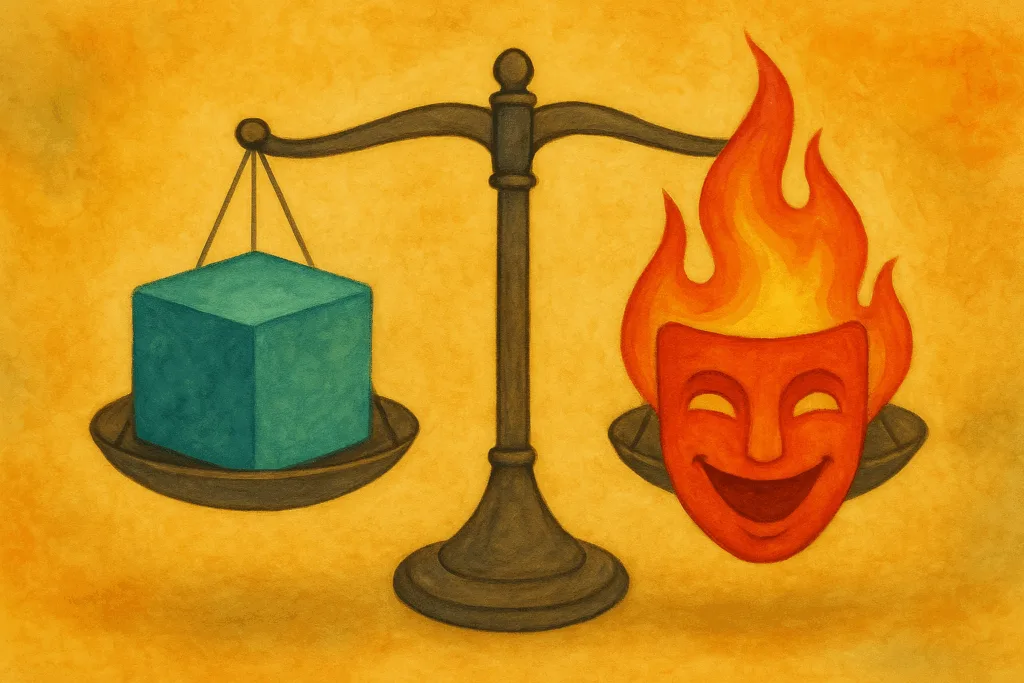5 to 8% of autistic people are believed to be affected by bipolar disorder, and yet, this association between the two conditions is rarely mentioned in the literature. When you type “autism and bipolar disorder” into Google, finding a personal account can feel like a challenge. A few years ago, I took part in a podcast on this topic, sharing an experience that was almost unique—especially in France. The idea of a blog exploring both subjects in detail slowly began to form a few weeks ago. A few days later, the project was underway.
I have, however, mostly approached the topic of autism until now. Because a narrative choice had to be made: to explain each condition in detail independently before describing how they interact — interactions that, from the outside, can look like a firework display. If I chose autism as the editorial foundation, it’s because it is the condition that follows me daily, regardless of my mental state. Yet, the disorder that causes me the most trouble — the one capable of destroying my social life in a snap, annihilating my finances, and who knows what else — is this cursed bipolar disorder. The question is: why does this comorbidity, autism and bipolarity together, remain so invisible?
Focused Studies
Studies tend to ignore the second condition when examining one. That is why we have a plethora of research on autism, and just as much on bipolar disorder — but very little on the two combined. Sometimes, study samples even exclude people who present the comorbidity. This happens partly due to parallel symptoms.
Overlapping Symptoms
Autism and bipolar disorder can occur in the same patient, but one can also be a differential diagnosis for the other. Meaning: symptoms of one condition can resemble symptoms of the other. For example, consider what is known as logorrhea: the act of speaking continuously, often rapidly, as if the stream of thoughts never stops. This is a symptom of bipolar manic episodes and gives the impression the person could speak forever without pausing.
Does that remind you of something? Whether you’re autistic yourself or you know someone who is, you may have noticed that ability to unravel a sometimes Herculean stream of thoughts without leaving room for the other person to speak.
Speaking as someone affected by both conditions, there is a nuance: in logorrhea, the flow is usually chaotic — the person jumps from topic to topic and the thread of thought is not always easy to follow. Among autistic people without bipolar disorder, the flow is typically oriented toward a special interest and often unfolds as an organized stream of information — sometimes to the point of monopolizing the conversation simply because it needs to reach its natural end.
My friends can easily tell the difference between when I’m speaking nonstop because I want to infodump about a topic I love (autism), and when I’m speaking nonstop as if pushed by some mysterious external force to release a massive, not necessarily relevant stream of information (logorrhea).

Another point that can create confusion is reduced sleep. An autistic friend of mine was long mistaken for bipolar because of his insomnia, before being re-diagnosed. The difference: he suffered from the fatigue, whereas during mania I don’t sleep but feel no exhaustion at all (I once stayed awake for five days without any drowsiness). Once again: similar symptoms, different causes and consequences.
This makes diagnosis complicated, and it’s one of the reasons many autistic people are incorrectly diagnosed as bipolar.
One Diagnosis Masking the Other
Following the same logic, it’s important to understand how easily one diagnosis can hide another. Many autistic people diagnosed later in life are first diagnosed with bipolar disorder. That bipolarity ends up masking symptoms that, in hindsight, seem obvious. I myself was diagnosed bipolar four years before being diagnosed autistic. And yet, my bipolar disorder had begun five years earlier and masked all my autistic traits during that time.
The explanation: some episodes seemed to soften my autistic traits, while others amplified them. How does one figure themselves out in such circumstances? One moment I looked undeniably autistic, the next almost not at all. And whenever I appeared “more autistic,” I also appeared “much more insane.” Whether the term insane pleases people or not, it was the one used to describe me for a long time, right up until the diagnosis.

So it becomes even more difficult to diagnose a condition when it is hidden behind another. I speak from my own situation, but the reverse can also happen: autism masking bipolar disorder, through more rigid routines, special interests into which the person pours far more energy than usual, or an unusual focus on detail during psychotic episodes. It’s a real puzzle, even for psychiatrists, to the point where mine told me (and to her credit) that she was not competent regarding autism. She couldn’t make a call in my case, simultaneously typical and atypical.
Opposing Diagnoses
Diagnostics that appear incompatible?
Autism is often imagined as stable, predictable, calm — while bipolar disorder is perceived as cyclical, overflowing, and chaotic. Even my psychologist once told me she found the association of both conditions troubling because they seemed incompatible. Yet this idea is a false contradiction, and I’ll explore it more deeply in a future article. Some shared genes have even been identified — genetic vectors present in both conditions. They are two separate diagnoses, and the apparent opposition of their symptoms does not invalidate the possibility of them occurring together. It simply increases the contrast and intensity of how they manifest.

A confusion between symptoms
I mentioned earlier how symptoms can overlap in someone who is autistic and bipolar, and I can illustrate this with other examples from my life — examples that even managed to mislead my psychiatrist. In early August, I started writing a book. In 7 days, I had completed 200 pages. The first draft was even remarkably solid. It was mistaken for a simple manifestation of my autistic special interest — when in reality it was the beginning of hypomania, and then mania, with catastrophic financial consequences.
Similarly, my meltdowns can easily be confused with manic rage episodes, which makes identifying the nature of a crisis even more complicated. I still have to learn how to recognize the signs of each so I can live with them more easily. Even scientific literature struggles to differentiate all this — and may either confuse bipolar disorder with autism, or do the opposite: fail to associate them when it would be appropriate.
Masking
A brief word on masking, commonly seen in autistic women or gifted autistic people. These individuals often mask their autism from early childhood, sometimes to the point of mastering the art. Masking bipolar disorder? The logical next step. That’s how I slipped under the radar for five years after my first manic episode. I hid my depressions until one became so severe it could no longer be concealed.
I also hid some manic symptoms during my first episode: I knew I should be sleeping, so I pretended to. I would lie still, silent, in the dark if my parents opened my door — then go back to whatever I was doing once they left. Years later, I learned they had always known I wasn’t sleeping — they just didn’t know what to do.
Why so few personal accounts?
Although scientific literature acknowledges the possibility of this comorbidity, very few first-person accounts from autistic bipolar individuals exist. You can find some — mostly scattered across English-speaking forums — but you have to search for them. We can only hypothesize the reasons: double stigma (social challenges and external judgement tied to living with both conditions), vulnerability (sharing episodes that evoke shame), and above all the immense difficulty of untangling “what comes from bipolar disorder” from “what comes from autism.”
As someone who is autistic and bipolar, before starting this blog (and even now, since it requires enormous introspective work), I must constantly differentiate what stems from autism — therefore a part of me — from what stems from bipolar disorder — therefore, not my fault. Lean too much toward one side, and I risk excusing behaviors I am responsible for. Lean too much toward the other, and I risk forgetting that I live with a severe condition that shatters my ability to think rationally during episodes.

That being said, these are the reasons why I chose to be transparent in the writing of this blog — to give you a raw account of my autism and bipolar disorder. This article is only a first step. In the coming weeks, I will finally explore bipolar disorder in depth: hypomania, mania, mixed episodes, depression… and especially how these states interact with autism.
My goal: to offer clear reference points to those who live with — or alongside — this double reality.
For more information about Bipolar disorder
👉 Follow this path → Bipolar disorder hubOriginally published in French on: 12 Nov 2025 — translated to English on: 23 Nov 2025.

